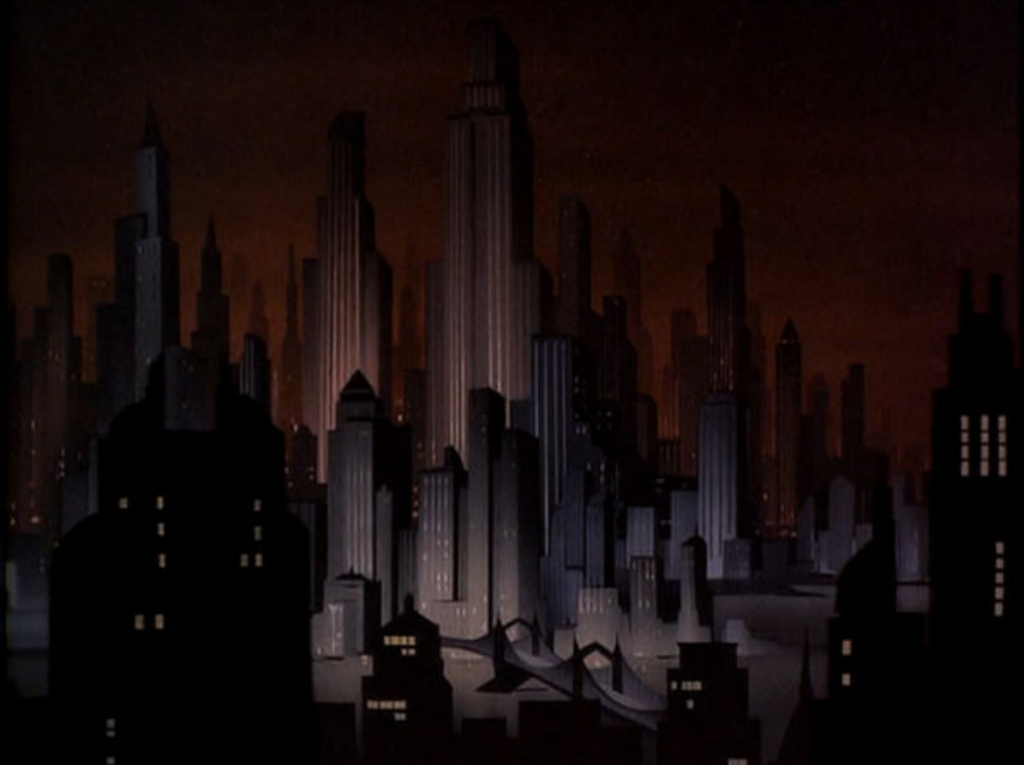Over the last 75 years, hardly a month has gone by without at least one story being published featuring a millionaire dressed as a bat, more often than not beating up the mentally ill. This is something that should make us think about who we are as a species. Or maybe it isn’t, but I have anyway.
In fact, I’ve spent an unreasonable portion of my life reading and thinking about Batman. And for the upcoming months, I will share those thoughts with you. This way, even those hapless mortals who have not devoured tons upon tons of pages full of ludicrous crime plots and eccentric clothing (and the occasional mutant gorilla) can also be exposed to some of the coolest things that are to be found in Batman comics.
The blog’s focus will not just be on Batman per se, but also on the universe around him, particularly on Gotham City, the place where ‘Sorry I’m late, but on my way here I was kidnapped and brainwashed by a deranged fan of Alice in Wonderland’ is a workable excuse. I am fascinated by all the world-building and oddities that have emerged over the years around what was initially a simple knock-off of pulp heroes like Zorro and the Shadow. There will be posts on key topics such as Robin’s puberty, Batman’s role in the perestroika, and the unbelievably high mortality rate in Gotham politics, as well as on more technical aspects, like Batman’s most idiosyncratic writers or the creepiest covers to feature the Joker.
In the name of fairness – and because I don’t want to keep writing ‘IMHO’ – in this first post I will outline my general views and bias regarding Batman stories. Batman, who also goes by the less descriptive yet more ominous title of ‘Dark Knight,’ has been featured in literally thousands of stories in comics alone, not to mention other media such as cinema, television, video games, and porn. Call it versatility or inconsistency, but here is a character who has a long tradition of stories with such diverse moods as pulp adventure…
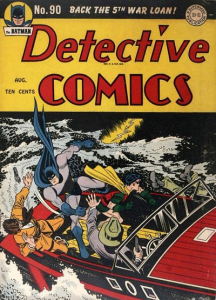

Detective Comics #90 Batman 1940s serial
…unapologetic camp…
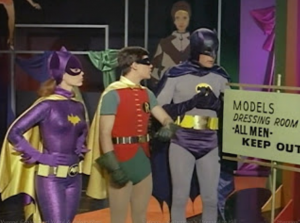

Batman tv series Batman #214
…gothic surrealism…
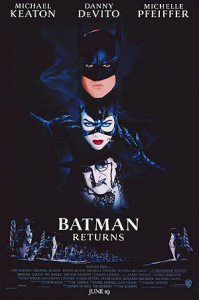

Batman Returns Batman: Red Rain
…slam-bang superhero action…
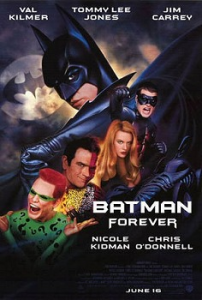

Batman Forever Batman and Robin #3
…and gritty crime thrillers.
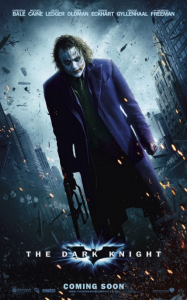

The Dark Knight Detective Comics #583
In a genre anchored by the weight of nostalgia, fans often prefer the style of the stories that first made them fall in love with the character. I am no exception. For me, like for many others in my generation, it all goes back to that moment when the Dark Knight, hanging from a zeppelin and stoned out of his mind on fear toxin, yelled at a giant hallucination of his father: ‘I am vengeance! I am the night! I am BATMAN!’ This means that, basically, my platonic ideal of how the Batman universe should be like comes straight from the cartoons I used to watch as a kid. For the most part, Batman: The Animated Series expertly walked a fine line, delivering stories that were moody and exciting, without feeling either overly grim or overly silly. Even weaker episodes tended to have stunning set pieces, like when Batman had to fight a massive deathtrap shaped like the solar system… And everything was made even cooler by Bruce Timm’s art deco, film noir-inspired designs:
The show’s interpretation of Batman and its villains was carried into the Batman Adventures line of comics, known for its fun tone and highly kinetic art style. Despite being kid-friendly, these comics – just like the cartoons that inspired them – did not feel the need to talk down to their audience. In fact, the sadly short-lived second volume of Batman Adventures – mostly written by Ty Templeton and Dan Slott – packed more clever twists, neat moments, and intricate subplots than any other ongoing series at the time. The Dark Knight faced Killer Croc, the Joker, the Cavalier, a recently elected Penguin, the police, and a horde of ninja assassins from the Society of Shadows – and that was just the first issue!
This is not to say that there aren’t plenty of great Batman comics outside the Adventures line. Throughout the ages the Caped Crusader, as he is sometimes alliteratively called, has found himself in a wide range of mind-blowing stories drawing on everything from murder mysteries to psychedelic sci-fi, from German expressionism to pop art, from serious social issues to supernatural mumbo-jumbo. Either because he is a fascinating character or simply because he is a popular one, Batman has attracted the best creators in the industry. Name your favorite mainstream comics editor, writer, artist, colorist, letterer, etc and s/he is bound to have crossed paths with the Dark Knight. Seriously, back in the 1974, DC published back-to-back issues illustrated by Howard Chaykin, Alex Toth, and Walt Simonson… yeah, eat your heart out, Mona Lisa!

Detective Comics #441
To be sure, being talented at doing comics is not necessarily the same as being talented at doing Batman comics. Critically acclaimed authors like Alan Moore and Neil Gaiman may have written their share of solid Batman stories, but if you want a straightforward tale that earnestly kicks ass while reveling in its own absurdity, you should look no further than Alan Grant. True, Grant’s dialogue has been known to cross the border over to the wrong side of cheesy (people get called ‘creep’ quite a lot) and his sense of subtlety can be best illustrated by the fact that he once penned a story called ‘Cats,’ featuring Catwoman, Catman, a couple of cat-catchers who drove around in a van labeled Schrodinger Delivery while exchanging feline factoids, and a cat burglar on top of the building of Hottin Roofing Inc, on Elliot Street. Regardless, Grant throws himself at the material with unmatched gusto, writing a badass Batman tempered with a healthy dose of dark humor and often coming up with truly twisted villains:
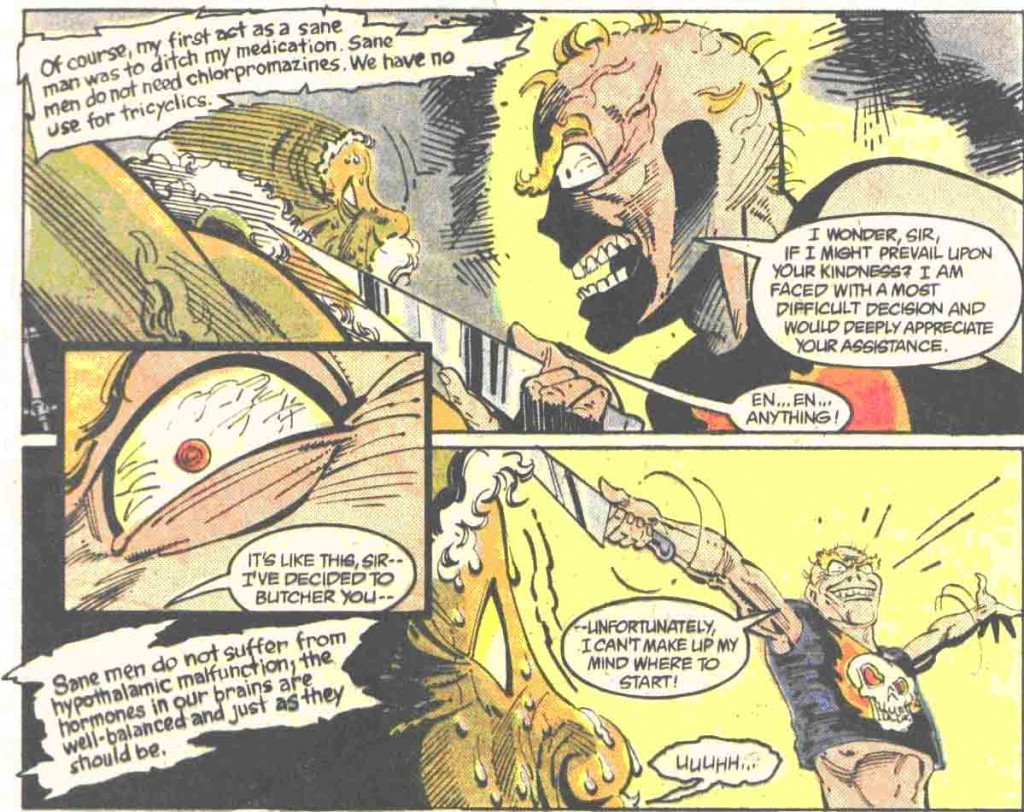 Detective Comics #593
Detective Comics #593
So what makes a Batman story great? If there is such a thing as an archetypical formula, it involves the Caped Crusader facing off against an interesting villain both intellectually (usually by tracking down the culprit or figuring out the next crime) and physically (by fighting a formidable opponent and/or escaping from a deathtrap). Then again, it wasn’t that long ago that Batman was sent back in time by an alien god and ended up hanging out with a crew of 18th century pirates – and that story was ten kinds of awesome!
Still, it may be useful to clarify upfront my understanding of what makes the Dark Knight himself work as character. In his very first appearance, Batman was described as a ‘mysterious and adventurous figure, fighting for righteousness and apprehending the wrong doer.’ Others would label him a fetishist urban vigilante psycho and, sure, there is some of that in there. But at the end of the day what defines Batman as a character – apart from his accurate belief that *everything* looks cooler with a bat-logo on it – is the fact that he hates crime and loves his city. As simple as that. And what makes this so much fun is that his city is Gotham. The. Worst. City. Ever.
Gotham City is everything that’s wrong with our world, but it’s not our world, it’s a nightmare born of all our kinks and phobias, with homicidal clowns and masked militias doing parkour on gargoyle-ornamented rooftops, tragic monsters, ancient demons, kitsch serial killers, avant-garde terrorism, genetic experiments gone wrong, and stereotypical gangs roaming the streets at night to the soundtrack of The Misfits’ ‘Where Eagles Dare.’ It’s a place so out there that its only hope is a bulked up genius with a very large car collection.
 Legends of the Dark Knight #7
Legends of the Dark Knight #7
It is in this screwed up city that Batman wages his war on crime. Of course a ‘war on crime’ may seem just as vague as a ‘war on drugs’ or a ‘war on terror,’ but a corporate-owned comic character is supposed to last a long time so authors can be forgiven for adopting such an open-ended mission statement. Given that Bruce Wayne’s motivation stems from the death of his parents during a mugging, the Dark Knight tends to focus on larceny and street violence, although he has occasionally also been known to branch out into areas as diverse as hate speech or real estate fraud.
Some write him as a super-cop – he was even fully deputized until the 1980s – or as a libertarian alternative to cops – who gets results because he doesn’t have to play by legal rules and respect citizens’ rights – but the best stories are those in which Batman simply does what no one else will do because he is the most dedicated and resourceful guy in town. He steps in whenever the authorities are too busy, too corrupt, or just baffled. And although his specialty is handling bizarre villains and unconventional threats, if necessary he will even take over from the fire department:
 World’s Finest #3
World’s Finest #3
But what makes the Caped Crusader such a special crime-fighter, apart from the twisted logic that it takes a costumed lunatic to catch another costumed lunatic? Well, while he is technically human, Batman is commonly written as a superhero. He may not be super-strong or super-fast, but his extensive martial arts training allows him to get away with some outlandish physical feats. He has a massive computer that does everything from generating poison antidotes in record time to hacking into top secret files, although admittedly this was more impressive in the early days of the internet… Crucially, Batman is also super-rich. Money may not give people *super* powers in the real world (although between his clout, egomania, and obsessive branding, Donald Trump does resemble a super-villain), but then again Batman, or more precisely Bruce Wayne, is not just rich. He is so rich that writers can shove any outrageous gadget into the plot without having to bother explaining to the readers how it came about:
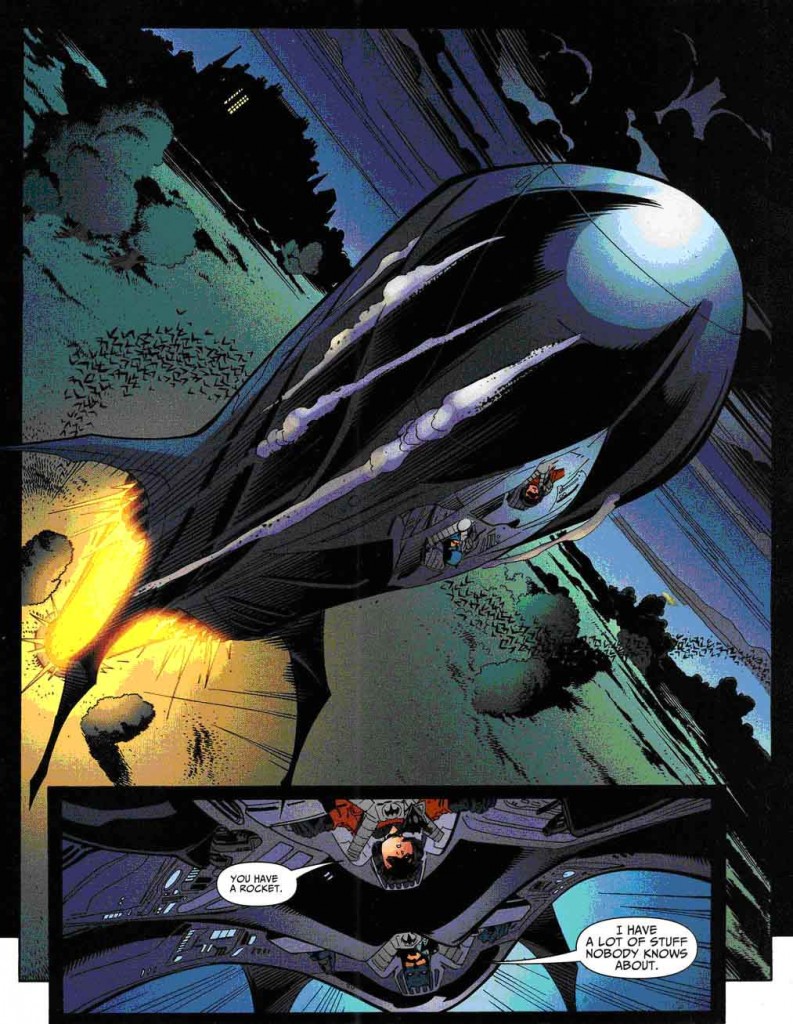 Batman #658
Batman #658
So if you want to read stories about a down-on-his-luck hero struggling to make ends meet, go check out Spider-Man instead. It should be noted, though, that as tempting as it may be to present Bruce Wayne as an Ayn Randian capitalist Übermensch fighting against the lower classes, it is usually disingenuous to do so, Nolan’s The Dark Knight Rises notwithstanding. Bruce Wayne’s wealth is more of a convenient plot-device than a thematic statement. After all, the millionaire playboy persona is no less of a disguise than his Dark Knight melodramatics.
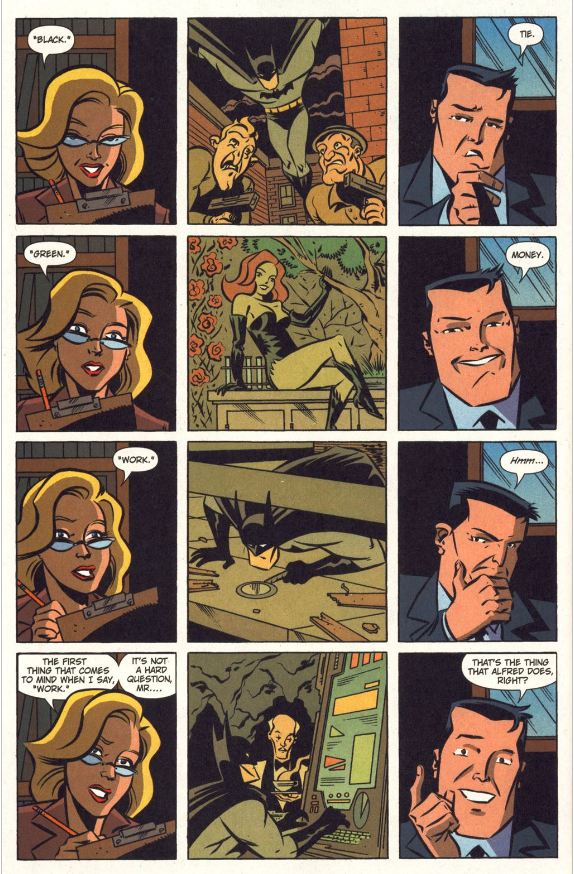 Batman Adventures (v2) #9
Batman Adventures (v2) #9
From a thematic point of view, Batman’s relentless determination is much more central to his character. Bruce Wayne is not just someone who saw his parents gunned down in front of him when he was a kid and hence vowed to dedicate his existence to the eradication of crime… he is a guy who, after making this childish vow, actually spends the rest of his life consistently focused on that one objective, studying, training, planning for every contingency, and literally going out into the streets every night just to punch criminals in the face.
Batman’s other distinctive trait concerns the fact that he is supposed to be, as the ads put it, the World’s Greatest Detective. Not just a good detective, but the greatest. In practice, this is sometimes easy to miss, as even good writers occasionally find themselves lazily disregarding the potential of such an epithet – instead of having Batman make ingenious deductions from improbable clues, they just stick to him being a tough interrogator (i.e. torturer):
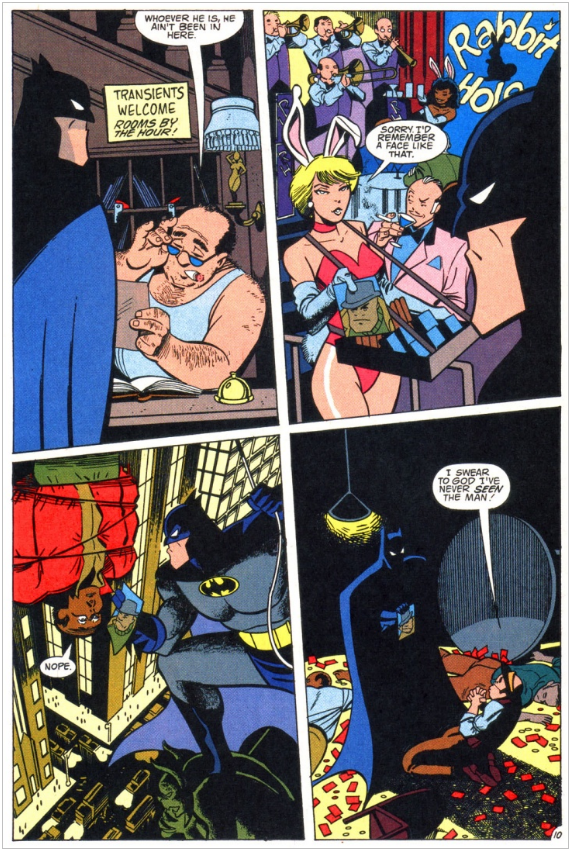

Batman Adventures #8 The Killing Joke
Yet in theory, being the World’s Greatest Detective means that Batman is highly intelligent, observant, and knowledgeable. In other words, writers can get away with having the Dark Knight make impossible calculations or draw on any piece of obscure trivia to move the story forwards. Or just show off:

Gotham Adventures #56
…that’s right, as if all this was not enough to make Batman a character begging for amazing stories, let us not forget that he also possesses this final, outstanding attribute: he has great taste in films.

